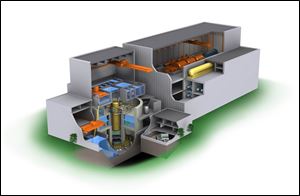
Utility files for license for 3rd reactor at Fermi
9/19/2008
This conceptual cutaway drawing shows the new breed of boiling-water reactor that DTE is considering. The nuclear core is on the left and the generators are on the right.
NEWPORT, Mich. DTE Energy yesterday applied for a license to build a third nuclear plant on its Fermi complex northeast of Monroe, following through on plans it announced in February, 2007.
The project could create 2,000 to 3,000 temporary construction jobs. Another 600 to 700 workers would be employed permanently at the plant.
DTE, though, has not committed itself to break ground. With the project s cost now estimated at $10 billion, a number of financial issues will be considered as the Nuclear Regulatory Commission sifts through the utility s 17,000-page application over the next four years, John Austerberry, DTE spokesman, said.
DTE threw out an estimate of $3 billion when the project was announced. As recently as a month ago, the figure was $8.5 billion.
Mr. Austerberry did not specify why the figure was bumped up to $10 billion. We re just talking in round figures. At the proper time, we will develop detailed price estimates. We re not there yet, he said.
Construction figures are tied largely to hard-to-predict prices for concrete, steel, and copper in the coming years, Mr. Austerberry said.
A new plant, under the speediest scenario possible, would not go online until 2018. Such facilities are expected to take six years to build following the four-year review process, he said.
DTE was motivated to file before Dec. 31 so it could become eligible for $300 million to $400 million in tax credits under President Bush s plan for jump-starting the laggard nuclear industry with $6 billion of incentives under the Energy Policy Act of 2005.
The NRC went almost 30 years without receiving an application to build a nuclear plant.
Wall Street, according to sources within that agency and the U.S. Department of Energy, took a dim view of the industry because of the cost overruns from the first generation of plants.
With the help of key members of Congress, including U.S. Sen. George Voinovich (R., Ohio), the industry was revived as legislation and oversight were streamlined.
More incentives were offered. The fleet of 104 existing plants are in various stages of power upgrades and in extending their 40-year operating licenses by 20 years.
NRC online records show DTE s application is the latest from a dozen utilities that have proposed 22 reactors on 13 sites in recent months. Most are in the South.
Anthony F. Earley, Jr., DTE chairman and chief operating officer, called yesterday s filing a significant milestone for the utility, which spent about $30 million preparing the application.
Ron May, DTE senior vice president, said utility employees and outside contractors worked in excess of 100,000 man-hours on it.
NRC officials had no immediate comment on the application, Viktoria Mitlyng, agency spokesman, said.
DTE has to break ground by 2013 to remain eligible for the subsidies.
The utility has settled on a design. It has chosen a new breed of boiling-water reactor by GE Hitachi Nuclear Energy, one that is expected to produce about 1,500 megawatts of electricity. That s roughly enough for 1.5 million homes. A single megawatt powers about 1,000 homes.
Fermi 2, a boiling-water reactor licensed to operate through 2025, generates 1,130 megawatts. Fermi 1 was an experimental reactor that was shut down in 1972.
We will never run an auto assembly line or a cold-rolled steel mill using windmills or solar panels, Mr. Earley said. You need big, baseload nuclear and coal power plants to keep them running.
Contact Tom Henry at:thenry@theblade.com or 419-724-6079.